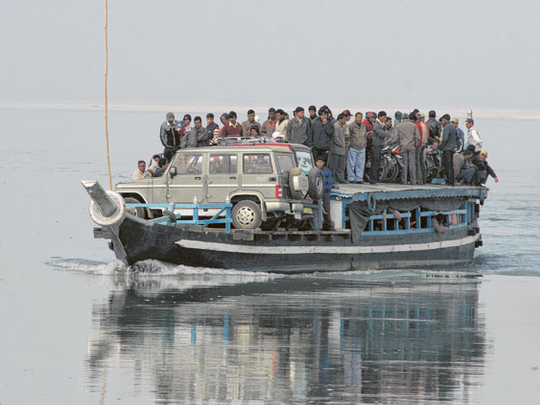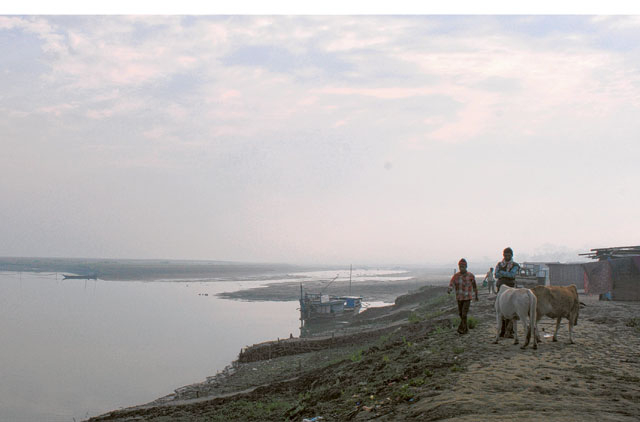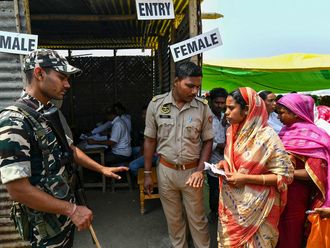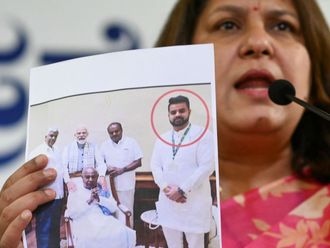
Bumping along the potholed roads of Majuli, our car slows to a halt to let a group of schoolchildren cross the street. Besides their schoolbags slung around their shoulders, the children are also carrying red plastic chairs held over their heads or tucked under their arms. I ask Bedabratta Dutta, our young islander guide, about the reason for this extra baggage. "The tide has probably washed away their school site," he explains casually. "So they've moved to another school further inland and are taking their chairs with them."
Even as I blink in surprise, the children walk towards the shimmering river, their red-capped heads bobbing purposefully in the distance like a plastic-coated mirage. An island of improbable beauty, Majuli is full of surprises hidden under its emerald surface. The landmass of the island is said to change shape every year, swirled by the tides of the massive Brahmaputra. Fishermen navigate their boats through internal water bodies that cover most of the island. The largest riverine island in South Asia, Majuli represents a state of rare and delicate balance of nature and human habitat. But with erosion shrinking its landmass from 1,256 square kilometres to about 514 square kilometres in 1990, the very existence of the island is hanging by a thread.
Much of the island's unique character comes from its relative isolation. Even today, there is no road link or bridges to Majuli. The only way to get there is by ferry, down the river. That is how we arrive, on a boat loaded with cars, motorcycles and a crush of people, from Nimatighat near Jorhat. It takes us two hours to complete the journey downstream, the Brahmaputra so swollen with its monsoon fullness that it looks like a vast, grey sea. The main town of Kamalabari, a short drive from the dock, slips by in a flash of small stores selling groceries, torches and clothes. It is no surprise to learn that the population of the island is just about 150,000.
For the most part, this community lives a simple life, depending on agriculture and fishing for a livelihood. Driving through a village belonging to the Mising tribe, we see their traditional bamboo huts rising on stilts in graceful symmetry. Baskets of fish dry on rooftops and women sit in the shade below the huts, working their looms with multicoloured threads. I ask a group of women if they will sell me the cloth they have made. It is clearly an unusual question. They look at each other, bewildered, for a while and then one announces boldly, "Yes, but for Rs100 [Dh8]!", before breaking into giggles.
This kind of purely nodding acquaintance with the ways of the "outside" (as they refer to the world beyond their shores) is evident across the island. While most residents want better health and education facilities for the island, they are also wary of being swamped by the impact of "development". Dutta, our guide, is one of the new generation of islanders trying to find a middle path between these two worlds.
As a teenager, Dutta was packed off to Guwahati along with his brother to study, partly because of the United Liberation Front of Assam (ULFA) insurgency, which played out over the 1990s. "During those days, the island was used as a hideout and base by the militants and there was an ULFA member in every house," he recalls. On the heels of the militants came the Indian army. For Dutta, the most poignant memories of those troubled years include working with Sanjay Ghose, the charismatic social activist whose organisation joined the local communities to help development and prevent soil erosion in Majuli. He was kidnapped and killed by the ULFA in 1997. "He was like one of us," Dutta recalls. "Everyone here was part of his efforts. We only found out how important he was after he died," he adds bitterly.
The years of violence, disappearances and whispered fears cast a long shadow for Dutta's generation. Perhaps that is part of the reason his brother chose a path that led far away from Assam, into a world of glamour and pretty make-believe. He now works as a successful sound designer in Mumbai and the portfolio Dutta proudly recites to us includes several big Bollywood hits. Dutta, however, studied history and chose to return to the island. "Life here is simple. We can get by on Rs10 a day and play football in the evenings," he says. More seriously, Dutta felt the need to create a new future for Majuli, which combines the best of both "island" and "outside".
"We don't want development like India," he says earnestly, "where everything is chaotic and crowded. We should be able to preserve our culture while making it open."
For this reason, Dutta has chosen to work in the fledgling eco-tourism industry, working at a lodge run on ecofriendly principles and taking tourists around the island in his spare time.
While for Dutta, Majuli's heart lies in its natural beauty, for our other guide, Haren Narah, the first stop every visitor should make is its satras, or neo-Vaishnavite monasteries. Narah belongs to the Mising tribe and follows the religion of Donyi Polo (literally, Sun-Moon). But that doesn't stop him from being completely at ease as he leads us into the Garamurh satra, chatting with the priests, showing us the best angle to photograph the striking statues of Garuda and advising us to wait for evening prayers.
In part, Narah's attitude comes from Majuli's rich past of assimilation and immigration. The island is home to a mix of tribes, including Misings (the largest group), Deoris, Sonowal Kacharis and other groups such as the Ahoms, Bengalis and Nepalese.
It is also linked to the spirit of the Bhakti movement, which the 15th-century thinker Sankardeva and his disciple Madhabdeva founded the satras around. An emphasis on tolerance and love over rituals and the quest to find the sacred in everyday life binds the 22 monasteries that survive across Majuli. Despite the fact that many satras had to be relocated due to erosion, the island is still the spiritual and cultural capital of Assam.
Hemanta Saikia, Nagaon-based activist and entrepreneur, points out: "Sankardeva was the father of Assamese culture and the monasteries preserve the entire range of arts, dance and music that flourished around the neo-Vaishnavite movement here."
Even today, the namghar (temple) is a community centre where people gather to talk, sing and pray. The satras also keep traditional art forms alive, such as the mask-making workshops we see at Samaguri satra. We are shown around a workshop by Dharmakanto Goswami, a priest and an artist, who leads us through a series of dimly lit rooms, its corners and walls covered with brilliantly painted masks of every size. Giant peacocks and monkeys tower over us, besides mythological characters, which are used in performances of the bhaona, which are colourful dance dramas. I see Goswami beckoning to me, crouching next to a particularly life-like mask of a rakshas, or a monster. I stare at the rakshas. He blinks back — and opens his mouth in a lazy snarl. Another Majuli surprise. It takes me a few seconds to realise that Goswami's hand is inside the mask, manipulating it.
According to legend, Majuli was a playground of the Indian deities Krishna and Radha. So taken were they with the emerald beauty of the island that Krishna declared it the next Dwarka. The legend of the deities is recreated all around the island during Ras Purnima celebrations in the month of Kartik (October and November). The Garamurh satra in particular is reputed to host spectacular performances of raas leela, or dance drama showing the Radha-Krishna romance.
On the evening we visit, however, dusk falls quickly and quietly over the monastery. In the prayer hall, an old man wipes the earthen floor with a mop, his oil lamp illuminating the brightly coloured paintings on the walls which depict scenes from the Chitra Bhagvata.
Two young women, following the island's code of "bring your own seating", carry bamboo mats into the large hall and join the priests in singing hymns, composed centuries ago. As their voices lift over the rhythm of the drums and the cymbals, it takes an effort to recall the world outside. We could be time travellers, spinning between eras.
We drive into the night, through forests with massive trunks and ancient, towering bamboo grass. The dirt road passes perilously close to the river, with fireflies hovering over its dark surface. We spend the night at Narah's eco-tourism resort, called "Me:po Okum".
It is a traditional Mising hut, modified to include an attached bath and other creature comforts for tourists. We sit out on the veranda with supplies of refreshments and a photo album, with pictures of previous visitors watching tribal dancers perform in their traditional dress.
Since it is off-season, we eat with his family in the kitchen. One of the boys serving us has come to Majuli recently, hired from a big resort in Guwahati in preparation for the tourist season. A sudden noisy scuffle between the livestock below us startles him almost as much as it does us city folk.
I ask him if he likes Majuli and he nods, a wary eye on his islander boss hovering nearby. Then, in a burst of confidence, he adds, "Too much wildlife here, though."
I fall asleep under a mosquito net, terrified by the noisy trilling of lizards on the roof. The morning bursts through the bamboo walls of the hut in a hundred pinpoints of light. It is time to leave the island. As I say goodbye, I tell Narah we hope to return in the winter. "Call ahead," he says brightly. "We may be full."
Helping hand from the government
On a recent visit, Indian Environment and Forest Minister Jairam Ramesh announced plans to declare Majuli an eco-sensitive zone and approved a financial package of Rs50 million in aid for the next five years to protect its rich culture and ecosystem. "Majuli is a region of unique bird and fish bio-diversity and an elephant corridor. Besides, tigers are also spotted (here) …, " Ramesh told media persons during his visit in April 2010.











_resources1_16a3106a819_small.jpg)

